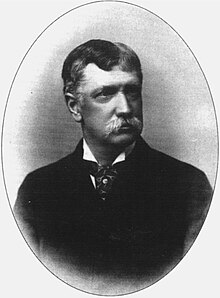Edward Francis Searles
| Edward Francis Searles | |
|---|---|

Edward F. Searles
|
|
| Born |
July 4, 1841 Methuen, Massachusetts |
| Died | August 6, 1920 (aged 79) Methuen, Massachusetts |
| Occupation | interior and architectural designer. |
| Spouse(s) | Mary Frances (Sherwood) Hopkins |
| Parent(s) | Jesse Gould Searles (1805–1844) and Sarah (Littlefield) Searles |
Edward Francis Searles (July 4, 1841 – August 6, 1920) was an interior and architectural designer.
Searles was born on July 4, 1841, in Methuen, Massachusetts, US to Jesse Gould Searles (1805–1844) and Sarah (Littlefield) Searles. His father worked in a local cotton mill and operated a small farm.
On November 7, 1887, Searles married Mary Frances (Sherwood) Hopkins, a wealthy widow 22 years his senior. The widow of Mark Hopkins, her assets included 25% ownership of the Central Pacific Railroad. Searles was the designer of Mary's new home in Great Barrington, Massachusetts, which is now referred to as the Searles Castle, from the 1885 groundbreaking, to its completion in 1888.
After Mary's death in 1891, Searles was left with his wife's vast real estate holdings in San Francisco, New York, Great Barrington, and Methuen, and $21 million. He died August 6, 1920.
During the remainder of his life, he satisfied his love of architecture by building a number of grand structures, frequently in collaboration with architect Henry Vaughan.
Collaborations with Vaughan include:
He was also an environmentalist and would alter the construction course of a major stone wall so as to preserve a tree that he deemed important.
His surname (as well as that of fellow "Methuen city fathers" Charles H. Tenney and David C. Nevins, Jr.) appears in the name of the "Searles Tenney Nevins Historic District" established by the City of Methuen in 1992 to preserve the "distinctive architecture and rich character of one of Massachusetts’ most unique neighborhoods". According to the City of Methuen:
Today, the trio’s collective vision can be seen in mills, housing, schools, mansions, churches, monuments, playgrounds, the library, and the architectural fantasies that resulted from their artistic rivalry. The historic district boundaries were established to include properties and buildings constructed or used by the Searles, Tenney and Nevins families and the people who worked for them.
...
Wikipedia
